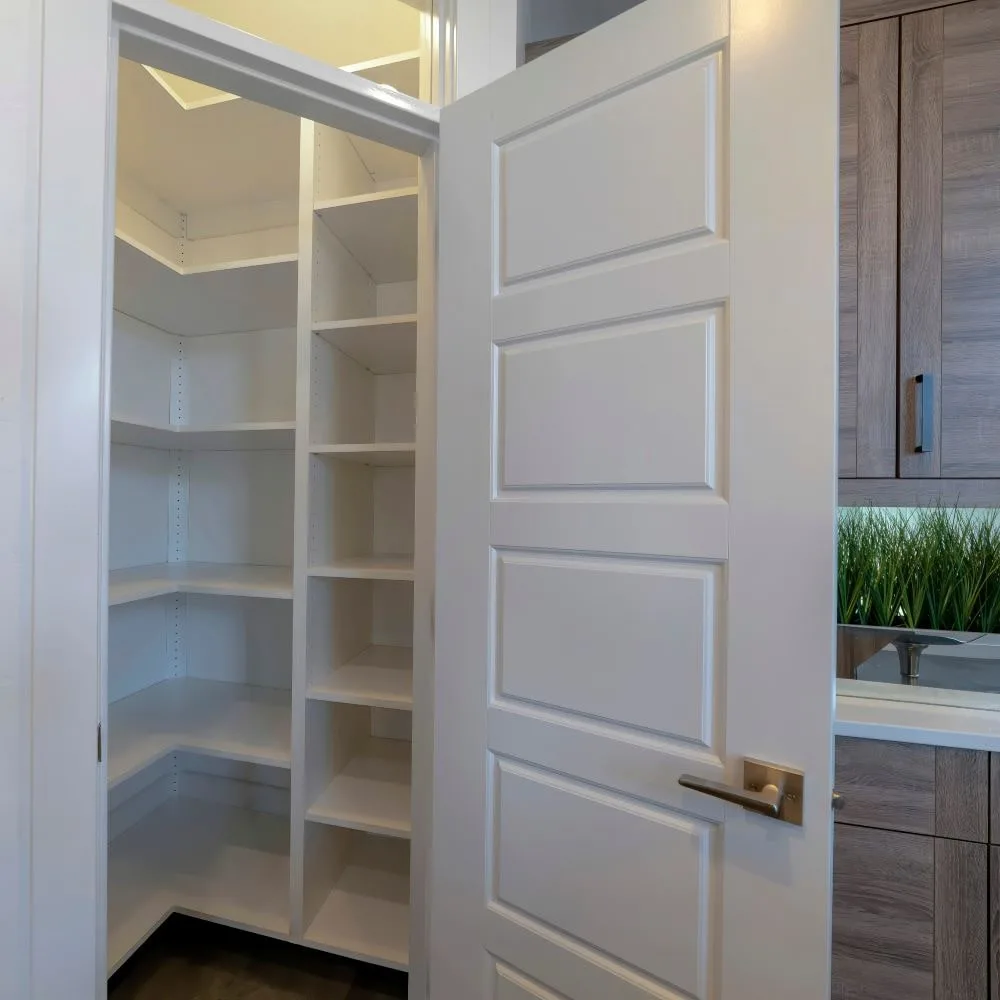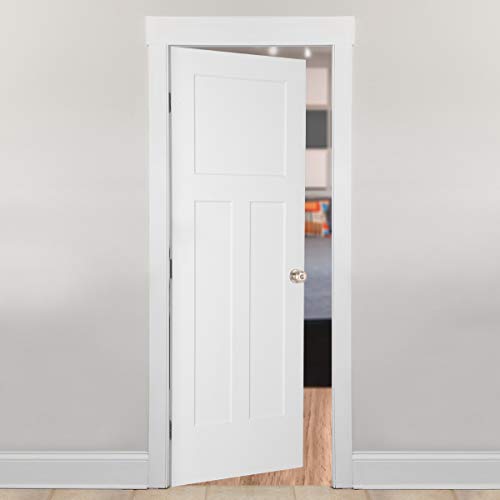If you have experience in home renovation and DIY, you might be familiar with the question that needs to be asked: which way should the door swing? It’s something that you wouldn’t necessarily think of at the start of any project, but there are regulations for the swing directions in code.
There are pros and cons for outward swinging and inward swinging pantry doors, and the decision is yours to make based on the layout of your pantry and kitchen as well as your personal preferences. Your pantry style and door size may also influence how much flexibility you have for the direction of swing.

In most cases, an outward swinging pantry door is better. An inward swinging door will block off most of the pantry and is only an option for large walk-in pantries. There is no code-regulated direction for which way a pantry door should swing.
No Official Rules for Pantry Door Swing Direction
The International Residential Code (IRC) has no specifications for pantry doors; size, swing direction, handing (or hinging), etc., are not regulated.
It contains guidance for egress doors and doors leading to stairs and staircases, but that is the extent of swing direction rules.
You can check your local state, area, city, or county codes for any potential amendments regarding the direction your pantry door should swing. However, I doubt you will find any relevant information.
So, it’s up to you for the direction your door swings, but there are logical reasons to guide your choice.
Corner Pantry: Outward Swing
There are pros and cons for corner pantries, and extra floor space inside the pantries is one of the pros. But, while they may be a little roomier, there is still not enough space for an inward swinging door.
You will be blocking off most of your pantry if you have an inward swinging door, and you won’t have the space to get around it.

Walk-in Pantry: Outward Is Still More Common
A walk-in pantry has the option of an inward swinging door because they are more spacious (too spacious?), so if you would prefer it, you can install a door as such. However, outward swinging doors are still the more common choice.
Benefits of a Pantry Door That Swings Out
- A door that swings outward on a walk-in pantry means that you are not losing any space within the pantry.
- You will not have to move the door to reach parts of the pantry.
- If you grab some items from the pantry, it will be easy to close the pantry door without having to come back once you’ve put down what you were holding.
- For any person who has mobility difficulties, an outward swinging door would make a walk-in or corner pantry easier to move around in without needing to get behind the door and without the loss of space.
Drawbacks of Pantry Door That Swings Out
- With a pantry door that swings out, you are compromising the space in the rest of your kitchen as long as your pantry is open.
- This can impact the operational flow of your kitchen if you have to maneuver around the door or half-close it over as long as you are retrieving ingredients and utensils.
- You are going to have to open your pantry door before you start unpacking your groceries, as it will be challenging to swing the door out with full hands.
Pros and Cons of Inward Swinging Pantry Doors
Inward swinging doors have their merits and pitfalls.
Positives of an Inward Swinging Pantry Door
- Inward swinging doors would allow you to install a pantry with floor space in a smaller kitchen as you wouldn’t be required to fit a door that would swing outward into countertops and cupboards.
- If you have any sight-impaired people or pets in the house, then the inward swinging door may help by not hindering their mobility space.
- You would not be able to close pets inside the pantry on accident (we all know how cats love to rush into places we wish they wouldn’t) as you would need to reach inside to pull the door closed and would therefore see any stowaways.
Negatives of an Inward Swinging Pantry Door
- The inward swinging door is going to cause trouble with accessing the pantry fully. You will end up blocking a part of the space with the door. In this case, you may end up abandoning regular use of the blocked area, which is a terrible waste of space.
- It would be easier for young children to accidentally shut themselves in a pantry with an inward swinging door, and because of the direction the door would need to open, they may struggle to get out.
- For accessibility purposes, a pantry with a door that swings in this direction would be less user-friendly as it would require maneuvering about in a small space in order to get to shelves and spaces behind the door.
How Big Should a Pantry Door Be?
There are no specific regulations for the size of a pantry door in the International Residential Code (IRC). You should always double-check with your local coding to ensure there are no amendments, such as those highlighted in this article on sizing pantry doors.
A good size for a pantry door would be 32” to 36” wide and 78” to 80” high.
Of course, the size of your door and the doorway may also depend on what type of door you are hoping to install. A barn-style door doesn’t take up any frame room, so you might not need as much, while a folding door may take up extra frame room that you need to account for.
Does a Pantry Need a Door?
Unlike the door to a bedroom or bathroom door, a pantry door is not necessary either by code regulation or for privacy purposes.
Pros of No Pantry Door
- You don’t have to worry about the door taking up space, either in the pantry or in the kitchen space.
- You could have a specialized opening size without the worry of having to fit a premade door into the frame or having to custom-order a door to fit. This could help with accessibility for the pantry.
- Having no door means free and easy access to the pantry. Which would also make the space more accessible.
Cons of No Pantry Door
- Pantries have a lot of odors, fumes, temperature-sensitive items, and are a place susceptible to mold and damp. As explained in this article on pantry ventilation, there needs to be a proper way to ventilate your pantry and protect it from unnecessary moisture, which would be harder without a door.
- Your pantry should be kept dark if possible as the light brings heat, making your food expire faster and facilitating the growth of bacteria.
- Kitchens get hot when you cook. Without a door, you are taking away a layer of heat protection for your pantry. This heat protection also extends to help protect against environmental heat.
- If your pantry is untidy (or filled with admittedly too much candy), then anyone coming into your kitchen can see this.



